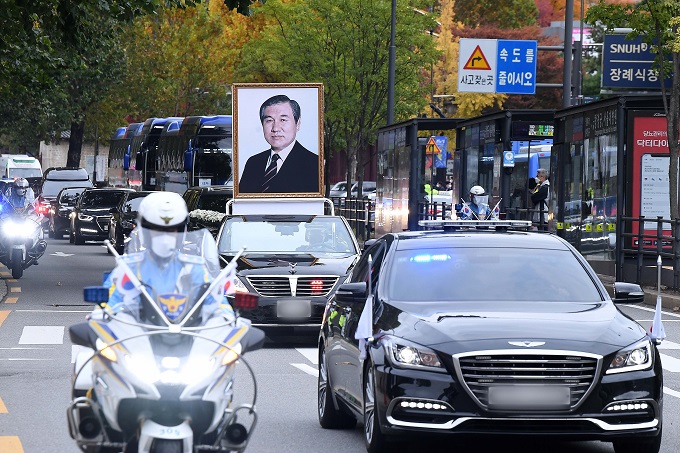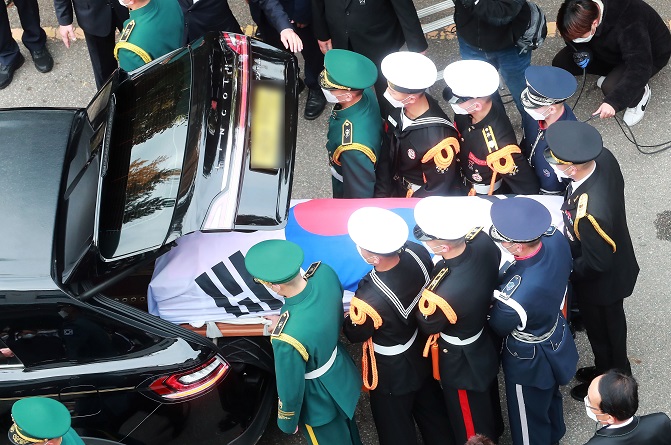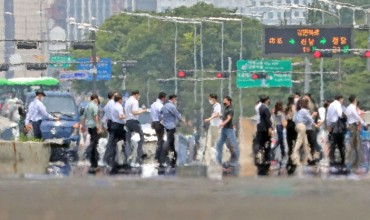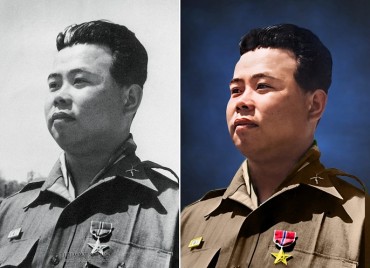
A funeral procession for late former President Roh Tae-woo heads to his Seoul residence to make a stop before going to the funeral ceremony at Olympic Park on the last day of the five-day state funeral, on Oct. 30, 2021. Roh, who led the country from 1988-93, died Tuesday of chronic illnesses at age 88. (pool photo) (Yonhap)
SEOUL, Oct. 30 (Korea Bizwire) — South Korea bid farewell to late former President Roh Tae-woo on Saturday, marking the end of a five-day state funeral for a leader who drew both criticism and praise for his role in staging a coup and then embracing democracy.
The funeral ceremony for Roh, who died Tuesday at age 88, began at 11 a.m. at the Peace Plaza at Olympic Park in eastern Seoul, a symbolic venue for him as it was there that the 1988 Summer Olympics were held successfully during his five-year term.
His body was brought from Seoul National University Hospital, where he died of chronic ailments after bouts with prostate cancer, cerebellar atrophy and asthma.
On the way to the ceremony, a Lincoln limousine carrying Roh’s body, along with a convoy, made a brief stop at Roh’s residence in western Seoul, as part of a funeral tradition, that was attended by his family and close aides.
The funeral procession entered Olympic Park, with the honor guard carefully carrying the coffin into the plaza where a dirge being played by an Army orchestra resounded through the site.
“Today’s funeral should be an occasion of mourning for the deceased, and an occasion of reflection toward a new history, history of truth and history of reconciliation and unity,” Prime Minister Kim Boo-kyum, head of the state funeral committee, said in a eulogy.
“Today, we once again realize the solemn fact that no one is free from history,” Kim said.
Roh, who served as South Korea’s last general-turned-president from 1988-93, leaves behind a mixed legacy.
He has been heavily criticized for helping his predecessor Chun Doo-hwan seize power through a 1979 military coup and ruthlessly crack down on a pro-democracy uprising in the southwestern city of Gwangju the following year.
He has also been praised for restoring the direct presidential vote, through which he was elected, and establishing ties with socialist states in the post-Cold War period, including the Soviet Union and China.

An honor guard carries the coffin carrying the body of late former President Roh Tae-woo as the funeral ceremony began on the last day of the five-day state funeral, in this pool photo on Oct. 30, 2021. (Yonhap)
In the eulogy, Kim asked for the Gwangju victims and their families’ understanding over the government’s decision to hold a state funeral for Roh, noting that Roh expressed an apology and forgiveness through his will.
“We fully understand those of you who oppose the state funeral,” he said. “Despite the many achievements of the deceased as president, we are simply unable to just mourn his death today because there are still many tasks left to be resolved by our community.”
“Yet we know that true reconciliation begins when we uncover the truth and ask for understanding and forgiveness from the victims … the past is not buried but lives as history that our community builds together,” Kim added.
The funeral ceremony was held under strict COVID-19 distancing rules. About 50 people, including Roh’s widow and former first lady Kim Ok-suk, his daughter and son, Roh’s close aides and sitting key government officials, attended the ceremony.
Some 1,000 citizens crowded near the fences along the Olympic Park to watch from a distance, even though it was impossible to see the ceremony because the funeral hall was covered with black tents to keep any outside spectators at bay.
A few hundred activists held rallies in front of the park to protest against the state funeral, calling the government’s decision to honor Roh in such a way as “a cowardly act.” No clash broke out between them and the police.
About 2,000 mourners visited the funeral home at the hospital to pay tribute over the past five days, according to the Rohs.
Roh’s body was to be cremated before being laid to rest. The government has yet to announce where Roh will be buried, although his family has reportedly been looking at a site on Unification Hill in the border town of Paju, 30 kilometers north of Seoul.
The tourist and natural attraction was conceived under Roh as part of his administration’s efforts to promote peace with North Korea.
President Moon Jae-in was absent from the proceedings as he is currently on a visit to Europe.
His spokesperson earlier said he prayed for the deceased and delivered words of condolences to the bereaved family while noting that Roh had “not a few historical faults” but also achievements.
In his will, Roh asked for forgiveness from victims of the crackdown in Gwangju, which, according to conservative official data, left more than 200 dead and 1,800 others wounded.
The government’s decision to hold a state funeral was met with protest from critics who claimed the deceased did not deserve the honor. State funerals are paid for by the government.
By law, Roh is not eligible for burial at a national cemetery because he was convicted of crimes, including corruption and mutiny, and served time in prison before being pardoned in 1997.
(Yonhap)






